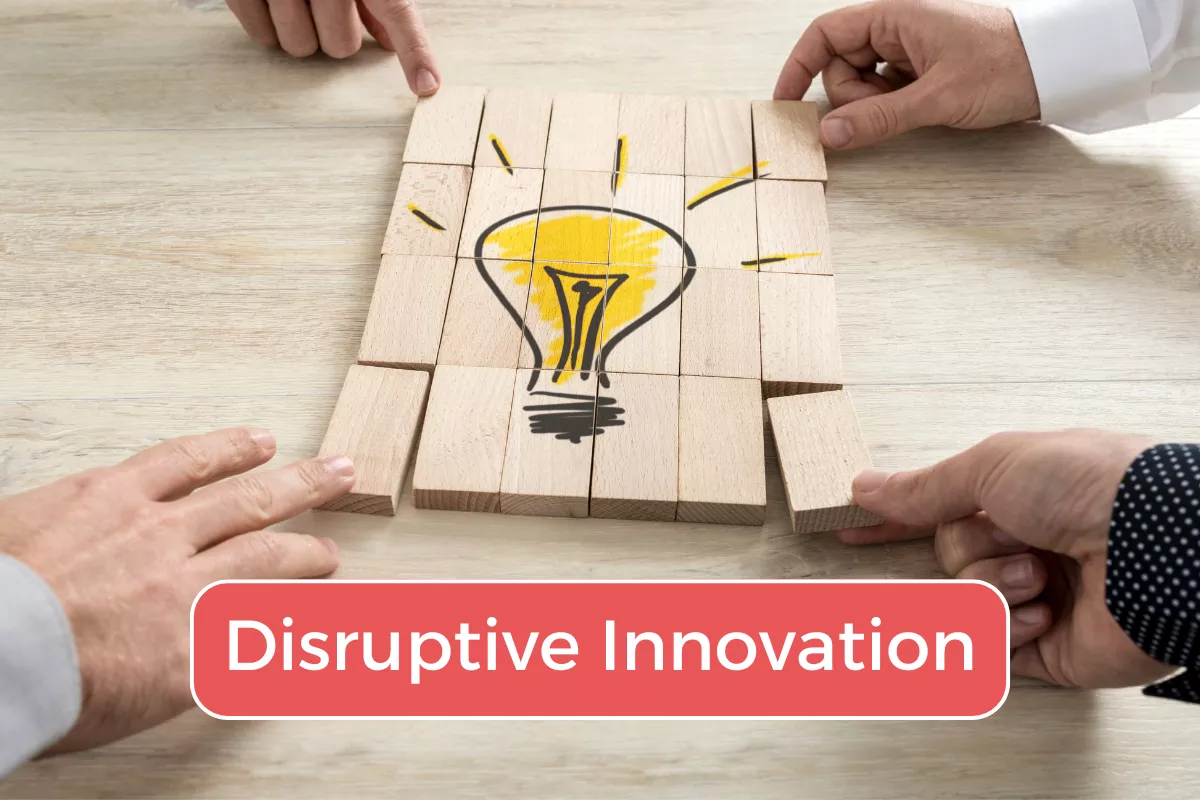The word disruption is everywhere, but do you really know what it means to be disruptive in IT? A lot of people think innovation is just about improving a product or service, but true disruptive innovation goes way beyond that—it breaks industry norms, reinvents business models, and makes traditional solutions obsolete.
In recent years, technology has been the main driver of these transformations. Companies like Netflix, Uber, and Airbnb didn’t just improve their markets—they completely changed the way we consume entertainment, transportation, and travel. Instead of going head-to-head with industry giants, they rewrote the rules. Of course, that’s easier said than done.
But what about your business? How can you bring disruptive innovation into your company? How can you not just keep up with change but actually lead it? That’s exactly what we’ll dive into in this article—what disruptive innovation is, how it’s shaping IT, and, most importantly, how you can use it to stay ahead of the competition.
What Exactly Is Disruptive Innovation?

The term disruptive innovation was coined by Harvard Business School professor Clayton Christensen in the 1990s. But here’s the catch: not every innovation or technological advancement is truly disruptive. Real disruption happens when a new product or service creates an entirely new market or serves an audience that was previously overlooked.
In other words, disruptive innovation occurs when a new product or service targets an underserved market or creates a brand-new one—in such a cost-effective and efficient way that it eventually makes traditional solutions obsolete.
Incremental Innovation vs. Disruptive Innovation: What’s the Difference?
Many companies confuse incremental innovation with disruption, but they are two very different concepts:
- Incremental Innovation: This refers to gradual improvements in existing products and processes. A classic example is the evolution of smartphones, which gain new features with each generation, but the core business model and market remain the same.
- Disruptive Innovation: This emerges unexpectedly, often targeting niche markets that established companies overlook. Over time, it scales up, completely transforming an industry. It usually starts by serving less demanding customers (or even creating entirely new consumers) and eventually overtakes major industry players.
How Does Disruptive Innovation Happen?
According to Christensen, disruptive innovation follows a predictable pattern:
- A new solution enters the market, catering to a neglected or low-end segment.
- Established companies ignore it, focusing on their premium customers and high-end products.
- Over time, the new solution improves, lowers costs, and scales up.
- Eventually, it wins over mainstream customers, leaving the industry giants struggling to keep up.
Classic examples of disruptive innovation:
✅ Netflix (Disruptive Innovation): Netflix started as a DVD subscription service, attracting a niche audience that didn’t mind waiting a few days to receive their movies. Meanwhile, Blockbuster was focused on instant rentals. Over time, Netflix transitioned to streaming, eliminating the need for physical rentals altogether—making Blockbuster’s model obsolete.
❌ Uber (Not Disruptive Innovation): Although many consider Uber a disruptive company, Christensen’s theory suggests otherwise. Uber didn’t start by serving an overlooked market; instead, it competed directly in the urban transportation industry from the start. Unlike a classic disruptor, Uber targeted an already established market with an improved service—making it more of a sustaining innovation rather than a purely disruptive one.
What Does This Mean for Your Business?
Disruption isn’t exclusive to Silicon Valley giants. Any company, big or small, can be a disruptor—or get disrupted. The key is identifying opportunities where major players aren’t looking and developing simple, accessible, and scalable solutions.
If your company is only focused on internal process improvements and incremental upgrades, you might be missing the chance to become the next big disruptor in your industry. The real challenge is: how do you spot and seize these opportunities before your competitors do?
In the next sections, we’ll explore how disruptive innovation is reshaping IT and how your business can position itself to lead this transformation. 🚀
The Impact of Disruptive Innovation in IT

Disruptive innovation doesn’t happen overnight. Most of the time, a new technology starts as an alternative solution, serving a specific niche, and gradually expands into the mainstream market, making traditional models obsolete.
Here are three major forces driving disruptive change in IT:
1️⃣ Entire Markets Are Being Redefined
Cloud computing, Big Data, artificial intelligence, and automation are revolutionizing industries like finance, healthcare, education, and retail. Companies that once relied on physical infrastructure and manual processes now operate on scalable digital platforms, making them faster and more efficient.
💡 Example: The banking industry is undergoing a massive transformation. Innovative fintechs like Nubank leverage cloud computing and AI to deliver fast, low-cost, and highly personalized financial services, putting pressure on traditional banks to step up their game.
2️⃣ Startups and New Players Are Setting the Rules
Unlike large corporations with rigid structures and bureaucratic processes, startups thrive on agility and flexibility. They can innovate faster and meet emerging demands before industry giants even notice the shift.
💡 Example: The rise of ChatGPT and other generative AI technologies is disrupting traditional software and marketing industries. AI-powered automation tools and virtual assistants are reshaping content creation, customer service, and data-driven decision-making, forcing tech giants like Microsoft and Google to adapt—fast.
3️⃣ Agile Mindset Is No Longer a Differentiator—It’s a Necessity
Companies that still rely on slow, rigid processes risk falling behind. Disruptive innovation isn’t just about technology—it’s about mindset. Organizations that embrace flexibility, experimentation, and continuous learning have a much better chance of staying competitive.
💡 Example: The DevOps model, which bridges development and IT operations, allows companies to release new features in days or weeks instead of months. This provides a huge competitive advantage, enabling businesses to quickly adapt to market changes and evolving customer needs.
How to Embrace Disruptive Innovation in Your Business
The first step to adopting disruptive innovation is building a culture of innovation within your company. This means encouraging experimentation, accepting failures as part of the learning process, and always pushing for creative solutions.
Shifting Mindset: The Culture of Innovation
To embrace disruptive innovation, companies must break away from resistance to change and foster an organizational culture of experimentation. This involves:
✅ Encouraging testing and prototyping – Small bets can turn into major breakthroughs.
✅ Accepting failure as a learning experience – Innovation requires trial and error, and not everything will work on the first try.
✅ Stimulating creativity – The best ideas emerge when teams have the freedom to think beyond the obvious.
Companies that understand this don’t just innovate faster—they become more agile, adaptable, and competitive.
Investing in New Technologies: The Driving Force of Disruption
Disruptive innovation is fueled by technological advancements that make traditional models obsolete. Here are some game-changing technologies you should keep an eye on:
🔹 Artificial Intelligence (AI) – Process automation, chatbots, predictive analytics, and machine learning for smarter decision-making.
🔹 Cloud Computing – Scalable, flexible, and cost-effective infrastructure that helps businesses adapt quickly to market changes.
🔹 Blockchain – Enhanced security and transparency in digital transactions, eliminating intermediaries and strengthening data reliability.
🔹 Automation & Robotics – Robotic Process Automation (RPA) to eliminate repetitive tasks, boost efficiency, and reduce operational costs.
Companies that invest in these technologies not only cut costs and increase efficiency but also unlock new business opportunities that were once unimaginable.
Adopting Agile and Flexible Methodologies
To innovate quickly, businesses must move away from rigid processes and adopt more dynamic and collaborative approaches. Here are three methodologies that can help:
🛠️ Scrum → An agile framework for software development, based on short cycles and continuous feedback.
🔄 DevOps → Seamless integration between development and operations, speeding up releases and improving system reliability.
🎨 Design Thinking → A user-centered approach to solving problems creatively and efficiently.
These methods aren’t exclusive to IT—companies across all industries can (and should!) use them to accelerate innovation and stay ahead of the competition.
Strategic Partnerships and Specialized Outsourcing
Building everything in-house isn’t always feasible. Partnering with specialized experts can make adopting disruptive innovation faster and easier.
NextAge is a perfect example, helping businesses innovate through:
🔹 Flexible, risk-free contracts → Test without commitment or financial risk.
🔹 A highly skilled team with a validated methodology → Experts dedicated to driving innovation.
🔹 Fast and efficient onboarding → Reduced learning curves and accelerated implementation.
If your company wants to lead innovation instead of just watching from the sidelines, now is the time to act. The world is changing fast—and those who don’t keep up will be left behind.
🚀 Want to stay ahead? Explore our services!
Examples of Disruptive Innovation in IT
Netflix: The End of Video Rental Stores

Netflix didn’t just change the way we watch movies and TV shows—it completely redefined the entertainment industry. What started in 1997 as a DVD rental service by mail evolved into the world’s largest streaming platform, effectively killing off physical rental stores and forcing traditional TV and film studios to reinvent themselves.
At first, Netflix’s idea was simple but innovative: a subscription-based DVD rental service that eliminated the dreaded late fees common in video rental chains like Blockbuster. But what truly made Netflix disruptive was its ability to anticipate technological trends and consumer behavior. While competitors clung to the traditional movie rental model, Netflix bet on the future—even before the technology was ready. Streaming was the goal from the beginning. So, when broadband internet became widely accessible in 2007, Netflix launched its online streaming service, directly challenging TV networks and cable providers.
The impact was immediate: customers realized they no longer needed to leave home to rent movies or follow rigid TV schedules. Netflix offered on-demand content, no commercials, and the freedom to watch anytime, anywhere. This shift gave rise to binge-watching, where users started consuming entire series in one go.
But the real game-changer came with original content. The success of House of Cards (2013) proved that Netflix wasn’t just a distributor—it was a full-fledged studio, competing with giants like HBO and Hollywood’s major studios. Since then, its investment in original productions has skyrocketed, leading to global hits like Stranger Things, The Crown, and Squid Game.
Meanwhile, Blockbuster, which once had the chance to buy Netflix for just $50 million, failed to adapt and eventually went bankrupt. Today, Netflix dominates the global market, reaching over 190 countries and reshaping the entire entertainment landscape.
Now, companies like Disney, Amazon, and Warner Bros. are scrambling to follow Netflix’s model, launching their own streaming services. What was once a groundbreaking innovation is now the industry standard.
🔹 This is the power of disruptive innovation—it doesn’t just improve an existing service; it creates a new model that changes the rules of the game entirely.
Airbnb: Reinventing Hospitality

Airbnb didn’t just introduce a new way to find accommodation—it completely transformed how people think about travel and property ownership.
The idea came from a personal necessity: in 2007, Brian Chesky and Joe Gebbia had just moved to San Francisco and noticed that hotels were fully booked due to a conference. To earn some extra cash, they decided to rent out space in their own apartment, offering guests an air mattress and breakfast. Simple? Yes. But the concept was revolutionary—it allowed anyone to become a host.
The early success showed there was an untapped demand: travelers wanted more affordable and personalized stays, while homeowners had extra space and needed additional income. Within a few years, the platform exploded, expanding beyond spare rooms to entire apartments, houses, and even unique accommodations like boats and castles.
Unlike traditional hotels, which focused on luxury and standardization, Airbnb thrived on authenticity and local experiences. The idea of “living like a local” became part of its brand identity. To enhance this, the company introduced neighborhood guides, host-led experiences, and even premium services like Airbnb Plus for high-end stays.
Of course, growth came with challenges. Regulatory battles, resistance from the hotel industry, and concerns about local communities all emerged. The COVID-19 pandemic also hit Airbnb hard, with bookings plummeting overnight. But the company adapted quickly—shifting focus to long-term stays and remote-work retreats, capitalizing on the rise of digital nomadism.
Today, Airbnb is more than just a booking platform. It redefined the hospitality industry and proved that with a simple idea and accessible technology, an entire market can be reinvented.
Why Uber Is Not a Classic Case of Disruptive Innovation

There’s no doubt that Uber transformed urban mobility, popularizing on-demand rides via app. However, despite common belief, Uber is not a textbook example of disruptive innovation—at least not according to Clayton Christensen’s definition.
Disruptive innovation occurs when a new technology or business model starts by serving an overlooked or underserved market, often with a cheaper and lower-quality solution that evolves over time to replace existing services. That’s what happened with Netflix, which initially targeted niche customers before replacing video rentals entirely.
Uber, however, didn’t follow this trajectory.
When it launched, Uber didn’t target an underserved market or offer a cheaper, lower-end alternative. In fact, its first customers were already using taxis and private car services. The early version of Uber was a premium service, using luxury black cars that were more expensive than regular taxis. Instead of targeting low-end consumers, Uber focused on convenience and exclusivity.
Uber’s true innovation lay in its technology-driven platform, which streamlined the connection between drivers and passengers, eliminating the need for dispatch centers or taxi stands. This was an example of sustaining innovation, improving an existing service rather than disrupting an entire industry.
It wasn’t until the launch of UberX—which allowed ordinary drivers to use their personal vehicles for cheaper rides—that Uber began competing head-on with taxis. This move shook up the industry, sparking protests, regulatory battles, and resistance from traditional taxi services. However, this impact came more from regulatory loopholes and operational efficiency than from true disruptive innovation.
At the end of the day, Uber represents a radical transformation in urban transport, but not because it created a new market or replaced an inferior solution over time. Instead, it optimized an existing service, making it more accessible and convenient through digital platforms.
Conclusion
Disruptive innovation isn’t just a buzzword—it’s a crucial factor for businesses that want to thrive in today’s fast-changing market. Companies that ignore disruption risk being left behind, while those that embrace it early turn challenges into opportunities and reshape entire industries.
At NextAge, we help businesses navigate this era of disruption, implementing cutting-edge technologies and developing strategies for sustainable growth.
Whether your company is just beginning its digital journey or looking for a strategic reinvention, having the right expertise makes all the difference.
🚀 Ready to take your business to the next level? Contact NextAge and discover how we can help you lead innovation in your industry!






